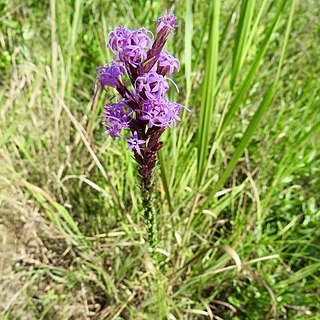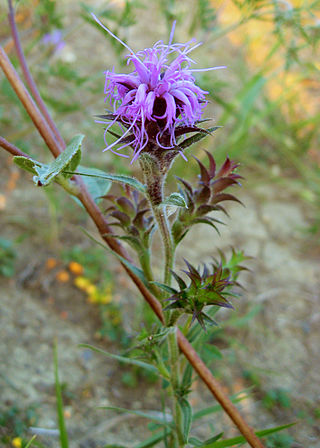
Liatris, commonly known as gayfeather and blazing star is a genus of flowering plants in the tribe Eupatorieae within the family Asteraceae native to North America. Some species are used as ornamental plants, sometimes in flower bouquets. They are perennials, surviving the winter and resprouting underground corms.

Liatris aspera is a perennial wildflower in the Asteraceae family that is found in central to eastern North America in habitats that range from mesic to dry prairie and dry savanna.

Liatris spicata, the dense blazing star, prairie feather, gayfeather or button snakewort, is a herbaceous perennial flowering plant in the family Asteraceae. It is native to eastern North America where it grows in moist prairies and sedge meadows.

Liatris acidota, also known as the Gulf Coast gayfeather, sharp blazing star and sharp gayfeather, is a plant species in the family Asteraceae and genus Liatris. It is native to Louisiana and Texas in the United States, where it is found in habitats that include coastal prairies, dry prairie and savanna, where it is found in sandy to clay soils.

Liatris aestivalis, also known as the summer gayfeather, is a plant species in the family Asteraceae and genus Liatris. The specific epithet, aestivalis, is derived from Latin and means "pertaining to the summer".
Liatris bracteata, commonly known as the bracted blazing star, or South Texas gayfeather, is a species of flowering plant in the family Asteraceae. It is native to Texas in the United States, where it is found in coastal prairies, roadsides, and along railroads with clay or sandy loam soils. This species is of conservation concern in its native range due to habitat loss.

Liatris chapmanii, also known as Chapman's blazing star or Chapman's gayfeather, is a plant species in the family Asteraceae and genus Liatris. It is native to Alabama, Florida and Georgia in the United States, where it is found in habitats such as dunes, beach strands, sand ridges, fields and roadsides, it also grows in longleaf pine savannas and other scrub habitats.
Liatris cokeri, also known as Coker's gayfeather and sandhills blazing star, is a plant species in the family Asteraceae and genus Liatris. It is native to North and South Carolina in the United States, where it is found in habitats such as sand ridges and sandy fields to roadsides; it is also found in turkey-oak and longleaf pine-oak plant communities. It blooms in late summer with purple flower heads.

Liatris compacta, sometimes called Arkansas gayfeather, is a herbaceous plant species in the family Asteraceae and genus Liatris. It is native to the Ouachitas of west-central Arkansas and eastern Oklahoma in the central United States, where it is found growing in habitats such as rocky ridges, bluffs, hillsides, weathered sandstone, and open woods. It blooms in June to September and may start blooming as early as May, it has purple flowers grouped into heads. It was known as a variety of Liatris squarrosa as Liatris squarrosa var. compacta until relatively recently.

Liatris cylindracea is a plant species in the family Asteraceae. It is native to eastern North America, where its populations are concentrated in the Midwestern United States. It is found in habitats such as prairies, limestone and sandstone outcroppings, bluffs, barrens, glades, woodlands and dunes.
Liatris cymosa, also known as Aggie-land gayfeather or branched blazing star, is a plant species in the family Asteraceae and genus Liatris. It is native to east central Texas in North America, where it is found in habitats such as post oak woodlands, fields, fence rows, woodland openings and edges, in clay soils. It blooms in mid to late summer with purple flower heads. It is of conservation concern due to habitat loss.

Liatris elegans, known commonly as pinkscale gayfeather, pinkscale blazingstar, and elegant blazingstar, is a species of flowering plant in the family Asteraceae. It is native to the southeastern United States as far west as Texas and Oklahoma.

Liatris helleri is a species of flowering plants in the family Asteraceae known by the common names Heller's blazing star and Heller's gayfeather. It is native to the Appalachian Mountains of the southeastern United States, found in the states of North Carolina, Virginia, West Virginia, and Maryland. It is threatened by recreational activities in its habitat, and is federally listed as a threatened species.

Liatris punctata is a species of flowering plant in the family Asteraceae known by the common names dotted gayfeather, dotted blazingstar, and narrow-leaved blazingstar. It is native to North America, where it occurs throughout the plains of central Canada, the central United States, and northern Mexico.

Liatris microcephala, known by the common names smallhead blazing star and smallhead gayfeather, is a species of flowering plant in the family Asteraceae. It is native to the Southeastern United States, primarily to regions of the Cumberland Plateau and Piedmont. The leaves of this plant are narrow and grass-like. It is found growing on exposed acidic rock such as sandstone or granite, as well as in open sandy areas. It is a perennial and flowers in late summer.

Liatris squarrosa, commonly called the scaly blazingstar, is an herbaceous perennial plant native to eastern and central North America, with most populations in the Southeastern United States. It is a somewhat conservative species, often found in dry or rocky areas of native prairie and savanna vegetation. It produces purple flowerheads in the summer.

Liatris squarrulosa, commonly called Appalachian blazing star or southern blazingstar, is an herbaceous perennial plant is the family Asteraceae. It is native to the Southeastern United States where it is found in naturally open communities, such as prairies and savannas.
Liatris lancifolia is a species of flowering plants in the family Asteraceae native to the prairies of central and western North America, known by the common names lanceleaf blazing star and Great Plains gayfeather.

Liatris ligulistylis is a flowering plant of the family Asteraceae, native to the central United States and central Canada.

Sisyrinchium campestre, the prairie blue-eyed grass or white-eyed grass, is a small herbaceous perennial plant in the iris family, native to prairie and meadow in the central United States and in extreme southern Manitoba.


















